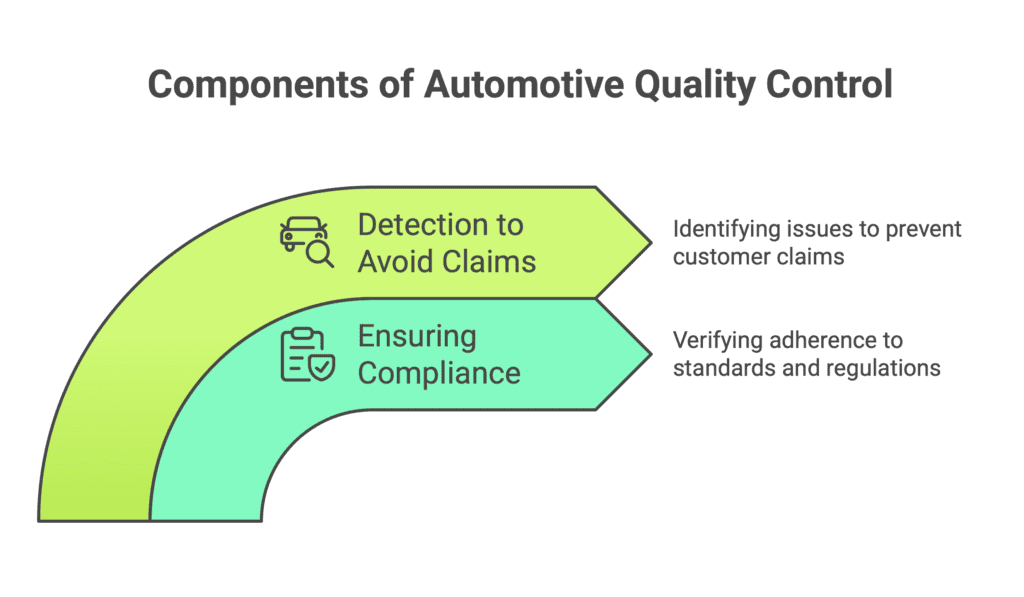The dynamic pace of change and strong competition in the automotive industry make maintaining consistent and high-quality standards increasingly crucial. To achieve this, suppliers employ two essential methods: Quality Control and Quality Assurance.
While these terms are often used interchangeably, they represent distinct approaches to ensuring compliance with design requirements. In this article, I will present the fundamental differences between Quality Control and Quality Assurance, shedding light on their unique roles in striving for improved production of components and systems
Quality Control in the Automotive Industry
Quality Control is a critical aspect of industrial production, particularly in the automotive sector. It primarily focuses on inspecting and, when necessary, correcting defects in intermediate components or finished products. This approach is reactive, centered on identifying differences and deviations after the completion of the production process.
The primary objectives contributing to the continued importance of Quality Control include:
Ensuring Compliance: Conducting checks as defined in appropriate documentation (e.g., Control Plans) allows verification of whether products meet established quality standards, regulations, and customer requirements.
Detection to Avoid Claims: Properly conducting verifications of manufactured components enables us to detect potential issues before they reach the customer, thus preventing claims.

And what about Quality Assurance?
In contrast to Quality Control, Quality Assurance is a proactive and preventive approach to guaranteeing product quality. It involves establishing a set of processes, standards, and guidelines to ensure that each stage of the production process meets the relevant quality criteria. Why should it be considered during the implementation of new projects?
Quality Assurance focuses on optimizing production processes, thereby reducing the number of defects and improving efficiency.
Another crucial aspect is the identification of potential threats in the production process. Its aim is to prevent problems and minimize the likelihood of defects occurring. This necessitates proper training and education for employees. Why? Because it serves as a complementary action that enhances the organizational culture by raising awareness regarding adherence to established quality standards. As seen, these aspects together form a cohesive quality assurance system.
Quality Control and Quality Assurance – Integration in Production
While Quality Control and Quality Assurance represent different approaches, they are not mutually exclusive. On the contrary, they complement each other to ensure a comprehensive and effective quality management system. Integrating both methodologies allows manufacturing companies to achieve a higher level of quality and customer satisfaction.
By using quality control techniques to identify and resolve defects in finished products, organizations can continuously improve their production processes through quality assurance.
Example
Consider two examples of automotive manufacturers effectively leveraging the synergistic effect between the two approaches:
Company X implemented a robust QC system involving rigorous testing and inspection of products. By analyzing data from these tests, they identified key areas requiring improvement. After identifying key areas requiring improvement, they integrated quality assurance measures to prevent recurring defects in the future. This integration resulted in a significant reduction in product returns and improved customer satisfaction.
Company Y focused on building a quality culture by introducing quality assurance principles across all production lines. This proactive approach reduced the likelihood of defects and facilitated better communication among employees, enabling quicker identification and resolution of potential issues.
In conclusion, both concepts are two essential pillars of automotive production, each serving distinct but complementary roles in achieving product excellence. While Quality Control identifies and eliminates defects, Quality Assurance focuses on process improvement and risk management to prevent defects from arising.
Manufacturers can create a reliable quality management system by embracing the strengths of these methodologies. Harmoniously integrating them enables the system to continually evolve to meet the demands of a dynamic industry. The pursuit of automotive production excellence through Quality Control and Quality Assurance is an ongoing journey fueled by commitment to continuous improvement and customer satisfaction.


